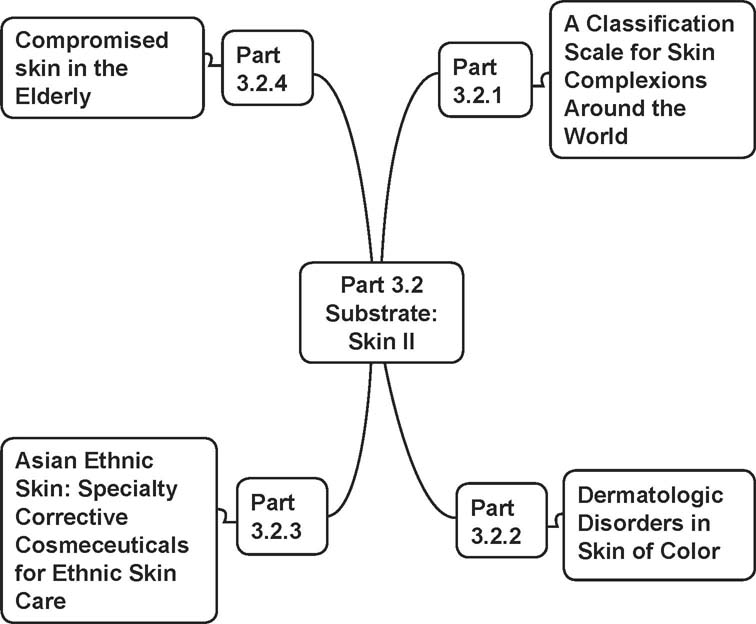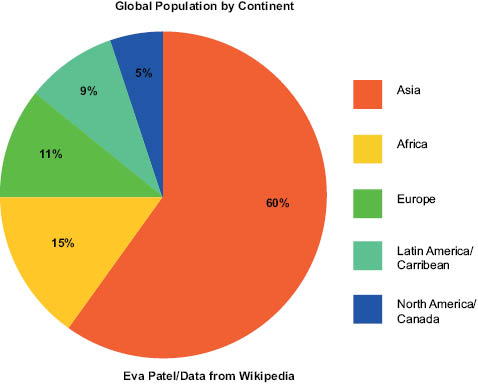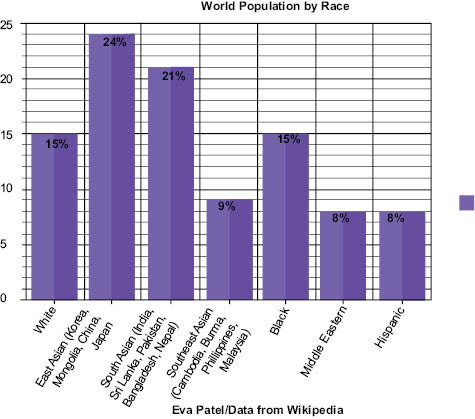SKIN II

PART 3.2.1
CLASSIFICATION SCALE FOR SKIN COMPLEXIONS
AROUND THE WORLD
Author
Eva Patel

Skin Rx Inc.
Founder & CEO
eva@skinrx.com
www.skinrx.com
ABSTRACT
Cosmetologists and aestheticians are daily faced with a wide variety of clients. In order to provide their skin with optimal health and beauty services these practitioners must accurately look at skin of different races and determine appropriate treatment protocols. Early projections of the changing global skin color landscape have now been proven to be accurate, and the main categories of skin color are no longer just Caucasian-white, but have evolved towards a dramatic escalation of brown, black, yellow, and the many shades in between.
The current scale available to the industry is the Fitzpatrick scale (Figure 4), which was developed in 1975 by Harvard dermatologist Dr. Thomas B. Fitzpatrick. The Fitzpatrick scale is described in this chapter as a custom and practice foundation for current practitioners. It is simple and easy to use; however, the method leaves a gap in the ability to classify skin in light of the evolving epidemiological landscape, and the system fails to accurately predict skin type and precautions for race, complexions, and skin characteristics.
Extensive research over the last decade reveals that beyond color alone, other key factors such as race, country of origin, and ethnicity play an important role in how the skin will respond to cosmetic and personal care products and procedures. Further, when the world is viewed as a whole, and countries are thoughtfully divided into sections, there appears to be an order that helps define how skin from similar regions acts in similar ways. This observation provides the basis for a new, more detailed skin classification scale. A proposal for this new scale is at the heart of the current chapter. The scale has been called the EP Global Skin Classification Scale (Figure 1) and is focused on an all-encompassing global approach that is comprehensive and easy to use for the skin care professional. (Figures 2 & 3 show additions to EP Global Skin Classification Scale.)
3.2.1 Why we need an updated Skin Classification Scale
3.2.2 The methodology in which the study was conducted:
3.2.4 Where Methodology Meets Results
3.2.1 WHY WE NEED AN UPDATED SKIN
CLASSIFICATION SCALE
The changing of global skin color landscape is now a reality; the majority is no longer just Caucasian but Asian, with the many shades of yellow undertones and shades ranging from light to dark olive complexions. The common skin conditions among the different races also differ; therefore skin has to be diagnosed and treated according to color and race and a one-size-fits-all method of the past no longer works.
The world is divided geographically into continents:
- ● Asia is the most populous continent, with its 4.2 billion inhabitants accounting for over 60% of the world population. (The world’s two most-populated countries alone, China and India, together constitute about 37% of the world’s population).
- ● Africa is the second-most-populated continent, with around 1 billion people, or 15% of the world’s population.
- ● Europe’s 733 million people make up 11% of the world’s population.
- ● Latin American and Caribbean regions are around 600 million (9%).
- ● Northern America, primarily consisting of the United States, and Canada, has a population of around 352 million (5%).
- ● Oceania, the least-populated region, has about 35 million inhabitants (0.5%).

Worlds Population by Race
East Asian 24% (Korea, Mongolia, China, Japan)
South Asian 21% (India, Sri Lanka, Pakistan, Bangladesh, Nepal)
Southeast Asian 9% (Cambodia, Burma, Philippines, Malaysia)
Black 15%
White 15%
Hispanic 8%
Middle Eastern 8%

USA
The USA is a diverse country of many races; the chart below shows the growth and census population over the past decade.
Race | Census 2010, population | Percent of population | Census 2000, population | Percent of population |
Total Population | 308,745,538 | 100.0% | 281,421,906 | 100.0% |
Single race | ||||
White | 196,817,552 | 63.7 | 211,460,626 | 75.1 |
Black or African American | 37,685,848 | 12.2 | 34,658,190 | 12.3 |
American Indian and Alaska Native | 2,247,098 | .7 | 2,475,956 | 0.9 |
Asian | 14,465,124 | 4.7 | 10,242,998 | 3.6 |
Native Hawaiian and other Pacific Islander | 481,576 | 0.15 | 398,835 | 0.1 |
Two or more races | 5,966,481 | 1.9 | 6,826,228 | 2.4 |
Some other race | 604,265 | .2 | 15,359,073 | 5.5 |
Hispanic or Latino | 50,477,594 | 16.3 | 35,305,818 | 12.5 |
NOTE: Percentages do not add up to 100% due to rounding and because Hispanics may be of any race and are therefore counted under more than one category.
Source: U.S. Census Bureau: National Population Estimates; Decennial Census.
The current scale that has been industry standard for the past 38 years is the Fitzpatrick scale.
The Fitzpatrick Classification Scale was developed in 1975 by Harvard Medical School dermatologist Thomas Fitzpatrick, MD, PhD. This scale classifies a person’s complexion and their tolerance of sunlight. It is used by many practitioners to determine how someone will respond or react to facial treatments, and how likely they are to get skin cancer.
Skin Type | Skin Color | Characteristics |
I | White; very fair; red or blond hair; blue eyes; freckles | Always burns, never tans |
II | White; fair; red or blond hair; blue, hazel, or green eyes | Usually burns, tans with difficulty |
III | Cream white; fair with any eye or hair color; very common | Sometimes mild burn, gradually tans |
IV | Brown; typical Mediterranean caucasian skin | Rarely burns, tans with ease |
V | Dark Brown; mid-eastern skin types | very rarely burns, tans very easily |
VI | Black | Never burns, tans very easily |
Fitzpatrick Classification Scale (Table 1)
The method leaves a gap in the ability to classify skin in light of the evolving epidemiological landscape, and the system fails to accurately predict skin type and precautions for race, complexions, and skin characteristics.
The EP Global Skin Classification tool was designed to fill the gaps by expanding the categories and taking into consideration global skin. The following categories were implemented:
- ● Race
- ● Country of Origin
- ● Complexion
- ● Skin Characteristics
- ● Skin Type
- ● Precautions
(See Figures 1-3)
EP Global Skin Classification Scale | ||||||
EP # | Race | Country of Origin | Complexion | Skin Characteristics | Skin Type | Precautions |
I | Caucasian I | Belgium, Denmark, Estonia, Finland, Germany, Iceland, Ireland, Latvia, Liechtenstein, Lithuania, The Netherlands, Norway, Sweden, Switzerland, United Kingdom, Canada,Greenland | Pale, Very Fair. Ruddy Freckled complexion. | Sensitive, thin fragile skin. Burns easily in sun, never tans, Age’s rapidly. Fine wrinkling occurs early. Orange peel skin as they age. Scars usually thin. Skin tends to be dry. | Hyper-Sensitive. Environmental Damage. Acne Prone. Skin Cancer most common in | Avoid excessive sun exposure and harsh, abrasive treatments. Bruising more obvious. |
II | Caucasian II | Andorra, Austria, Belarus, Bosnia & Herzegovina, Croatia, Czech Rep. France, Greece, Hungary, Italy, Kosovo, Luxembourg, Moldova, Monaco, Montenegro, Poland, Portugal, Romania, Russia, San Marino, Serbia, Slovakia, Slovenia, Spain, Ukraine, Vatican City, USA. | Fair. Light Olive undertones. | Sensitive, fairly thin skin. When exposed to sun will first burn then tan. Signs of aging appear early. Nominal Scarring. Dry to normal skin. | Sensitive Photo Damage Premature Aging Acne Prone Greater chance of skin cancer. | Can use certain peels and lasers with caution, Avoid harsh treatments as skin will be sensitive. Bruising obvious. |
III | Caucasian III | Australia, Bulgaria, Cyprus, Georgia, Greece, Macedonia, Malta, New Zealand, Turkey, South Africa, Zimbabwe | Fair Medium Olive undertones. | Seldom burns when exposed to sun, will tan, excessive exposure to sun will cause the skin to look leathery. Signs of aging appear later. Fine wrinkling less common. Scarring maybe thicker and darker. Normal to oily skin. | Environmental Damage Excessive Photo damage Acne Prone Skin Cancer common | May have tendencies of Hyperpigmentation with excessive sun exposure |
IV | Hispanic/Latino | Argentina, Belize, Bolivia, Brazil, Chile, Colombia, Costa Rica, Ecuador, El Salvador, Falkland Islands (Malvinas), French Guiana, Guatemala, Guyana, Honduras, Mexico, Nicaragua, Paraguay, Panama, Peru, Suriname, Uruguay, Venezuela. | Olive undertones. Medium to Dark Olive; wide range of Olive tones. | Depending on skin tone will rarely burn; will always tan, aging process is moderate. Darker, thicker scarring. Normal to oily skin. | Photo Damage Environmental Damage Hyperpigmentation Acne Prone Skin Cancer less common | Skin color & tone varies. Use caution with Deep peels and Laser. |
V | Mediterranean/Asian I | Afghanistan, Albania, Algeria, Armenia Stay updated, free articles. Join our Telegram channel
Full access? Get Clinical Tree
 Get Clinical Tree app for offline access
Get Clinical Tree app for offline access

| ||||





